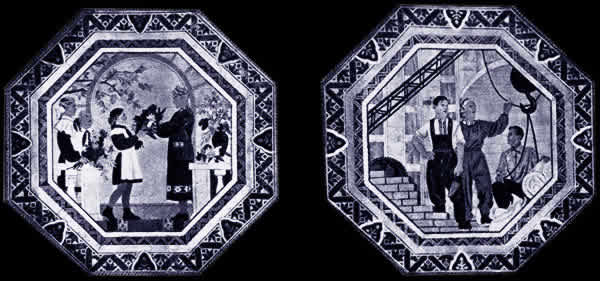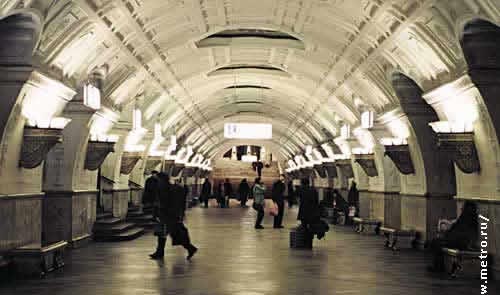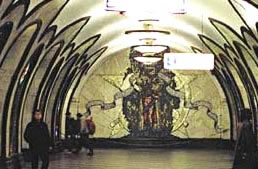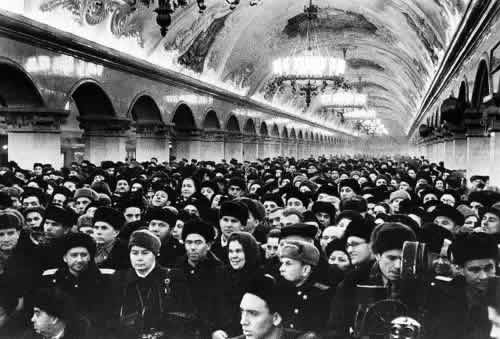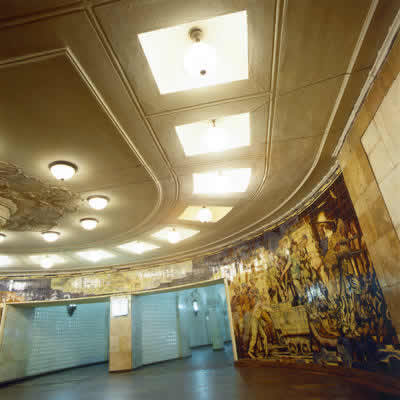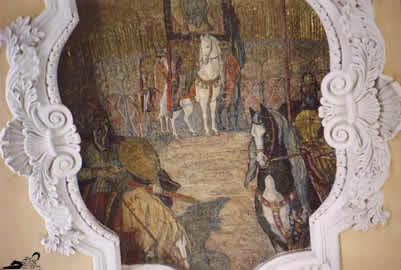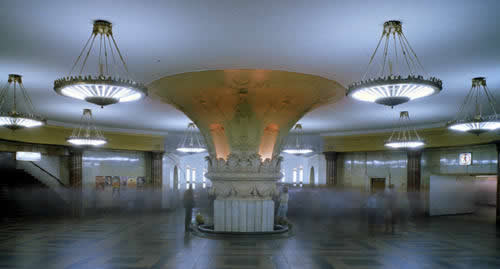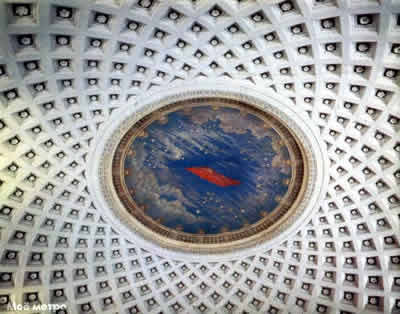|
The
Ring Line (Koltsovaya) – Part One
"Underground
2"
The Ring Line is my great
favorite. While on the Sokolnicheskaya and Zamoskvarechkaya Lines, at
least those constructed before 1950, there seems to be an overall concept
for the stations, with bigger or smaller variations, the Ring Line stations
are unique and original. The Ring Line’s construction to me is the
summit of the underground splendour: The war was over, reconstruction
had taken place, and the line itself served necessities not quite as urgent
as the former ones. It was, if you like, even more of a luxury than the
other ones.
This why this line takes
up so much space on this website.
The Ring Line has 12 stations
and covers a trajectory of 19,4 kilometers.
|
Belorusskaya
Station
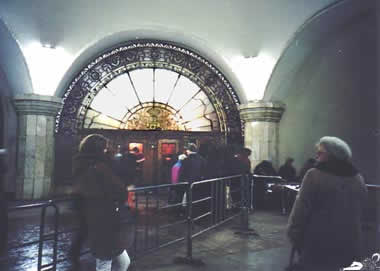 |
Belorusskaya Ring Line station (opened
1952)
Entrance hall
There is another Belorusskaya Station
belonging to the second line, the Zamoskvarechkaya, and of
course connected with the later one, which displays the usual
splendour of marble, granite and white tiles usual in the
30-ies.
|
But it was not devoted to the same aim
as the Ring Line’s: to make the Muscovites (and eventual visitors
of the capital) familiar with the popular art and culture of Belarus.
|
Bridges in Belorusskaya
Station leading from one direction’s platform to the
other, above the trains
|
|
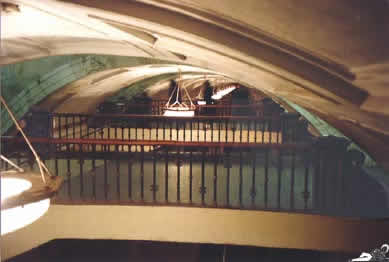 |
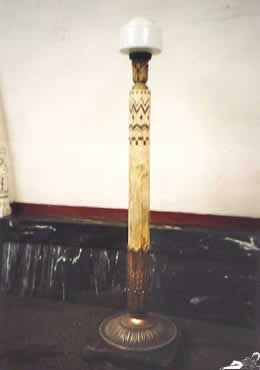 |
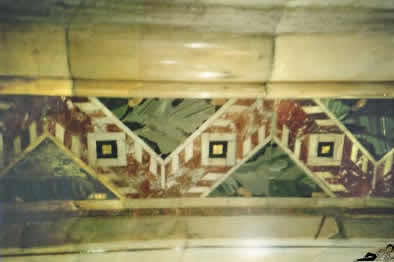
|
A stone mosaic decoration,
lining the wall at the top.
|
|
Lamp in Belorusskaya Station
These details show how the
art exposed in this station is meant to reflect the
popular art,
|
|
|
One of the numerous mosaics in the
ceiling picturing idealized scenes from the life of the Soviet
citizen, using special Belorussian patterns and motifs.
Of course, in order to enjoy them
thoroughly you have to almost break your neck.
|
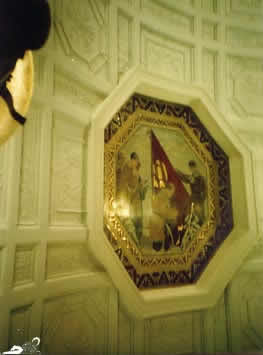
|
such as painting or embroidery,
of Belorussia.
Drawing, perhaps sketches
to the numerous ceiling mosaics.
|
|
It was arbitrary to start with this station.
But from now on there is order. The next station clockwise is Novoslobodskaya.
|
Novoslobodskaya
Station
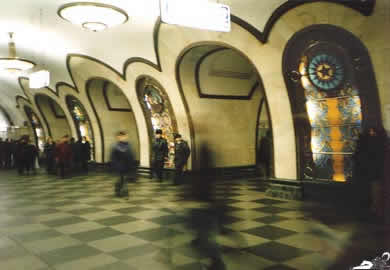 |
Novoslobodskaya Station (opened also in 1952). Main hall
The stained glass decorations obviously are meant to represent
the art of church windows. They were made by various artists
in Riga.
|
|
.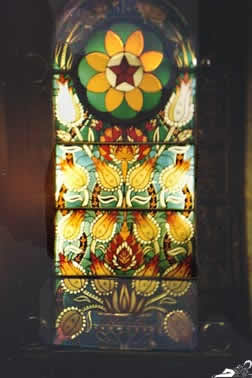
|
|
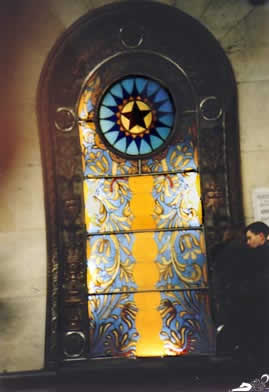 |
|
I do not really know how the design of this
station has to do with the name.
Novaya Sloboda was a craftsmen’s village outside of
old Moscow. Generally the word "sloboda", the old
slav word for "freedom", in Russia refers to a settlement
whose inhabitants had been freed from serfdom. Perhaps for this
reason they developed sacral craftmanship and art, out of gratitude.
Later the village was incorporated into Moscow, and probably
situated in the region where this station is. |
|
This large mosaic in the back of Novoslobodskaya Station
bears the title "Peace All Over The World".
|
|
|
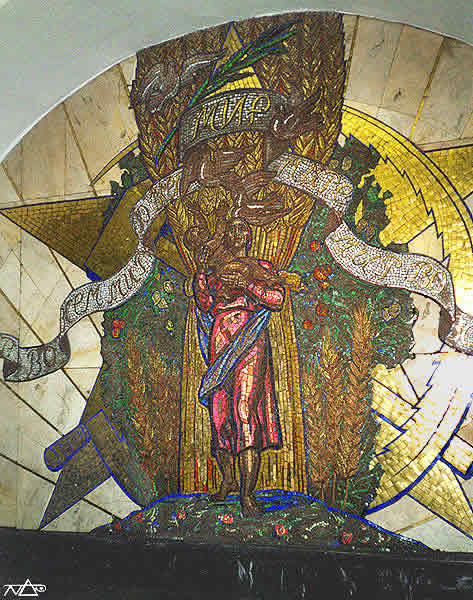
|
From the information obtainable on the web it seems
to be under restoration now.
Again one cannot help recognizing that the Soviet style
socialism evidently tried to present himself as an alternative
to Christian religion.
|
|
Below Moscow are many abandoned tunnels and stations.
They were built for strategic reasons, as the Soviet leaders already in
the 30-ies anticipated the problems to come. This way the Moscow Underground’s
planning is an interesting feature regarding the question whether the
Soviet politicians were prepared for the German invasion: It may be that
the exact moment or the direction it came from was unexpected, but they
already knew there was war coming some years before it actually started.
Already in 1935 the station "Sovietskaya" was
planned for the second stage of the underground construction, on the Arbatsko-Pokrovskaya
Line between "Teatralnaya" and "Mayakovskaya". As
its construction took place during the war it was designed to house the
Central Command for Civic Defence instead of serving as an underground
station, and therefore it was closed towards the tunnel by walls. Later
it occupied a space where a station would have been adequate, and its
different destination caused a very long trajectory without station, a
disturbing state of affairs that was only ended with the construction
of Gorkovskaya (now Tverskaya) Station in the 70-ies.
Sovietskaya Non-Station still exists, though closed to
the public. It is still destinated to serve as a shelter in times of war
– for the staff of the above located Moscow Authority for Emergency
Situations.
|
Prospekt
Mira
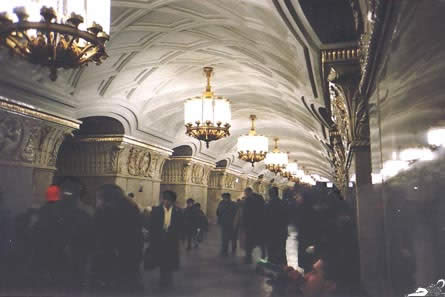 |
Prospekt Mira Station – the Station of the Boulevard
of Peace, opened in 1952
The main hall. Notice the small round reliefs in the upper
part of the columns.
|
These reliefs depict scenes from agriculture.
In the back, beyond the platform, you can see a wall
covered with red marble.
The other walls in the foreground are covered with white
marble.
|
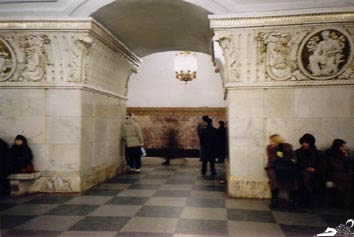
|
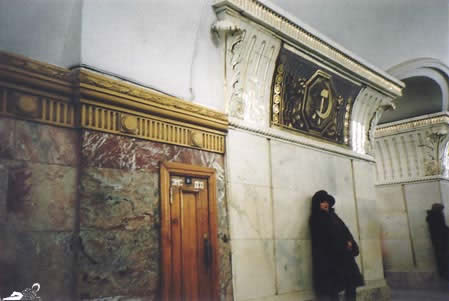 |
The side of the platform, with the omnipresent hammer
and sickle as decorations ...
The frieze on top of the columns is from ceramic.
|
|
Stalin had two bunkers during the war, one
near the stations "Sokolniki" and "Ismailovskiy Park",
the other one outside Moscow. The latter was built already during the
war with special strong ceiling support bars from cast iron. These bunkers
were connected to the Kremlin by tunnels of a size that allowed cars to
pass there. These tunnels still exist and belong into the sphere of the
Ministry for Disasters.
All the information about the secret tunnels
and even secret underground lines running to the dacha and elsewhere only
became public after 1991. Strange enough, they were first described in
detail in a publication of the US Defence Ministry of 1992, based on a
publication by the Soviet Armed Forces in 1991.
Later the Russian yellow press started to
publish such an amount of nonsense that most people lost the interest
in the topic or thought it was all an invention. The monthly "Ogonyok"
called these lines "Underground 2".
Then the theme disappeared again from the press, probably on some important
persons’ pressure.
|
Komsomolskaya
Station
The inauguration of Komsomolskaya Station in
1952
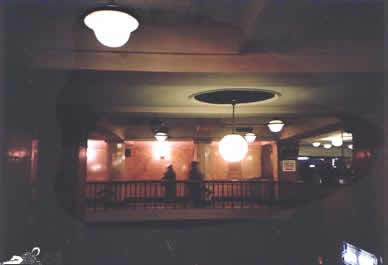 |
A part of the passage between the two Komsomolskaya Stations,
the one on Sokolnicheskaya and the one on the Ring Line.
|
|
Another part of the passage
The older Komsomolskaya Station (opened in 1938) was urgent,
as it connected the Kremlin with important train stations.
Therefore it is a little simpler than the Ring Line’s.
|
|
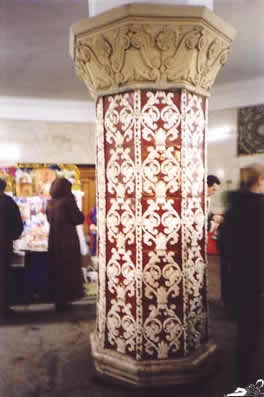 |
A column, somewhere in the entrance hall
of the station.
The two Komsomolskaya stations’ importance
lies in the fact that it is situated below the Place of the
"Three Stations": The Leningrad (perhaps today Petersburg)
Station, the Kazan Station and the the Jaroslavl Station,
each leading to a different direction: To Petersburg in the
northwest, to Jaroslavl in the northeast, and to Kazan in
the east.
|
| Detail from a part of the passage, already
entering the station. |
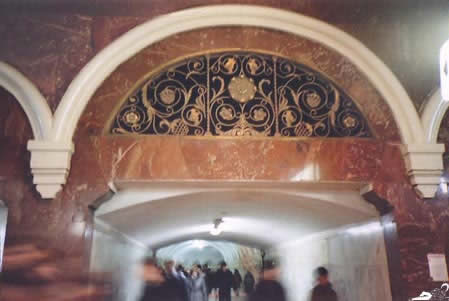 |
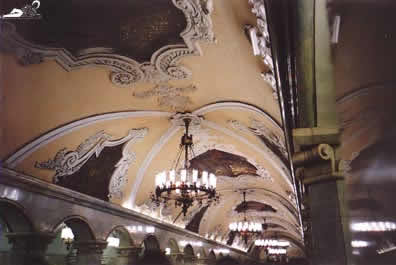 |
Komsomolskaya Station – Ring Line, just as the two
former stations, was also opened in 1952
The main hall
The mosaics on the ceiling tell tales of Russia’s
and Soviet Union’s belligerent past, –
|
|
– from Alexander Nyevskiy’s victorious battle
on the ice of lake Peipus/Chudskoye till the battles and victory
in World War II.
Detail from the ceiling decoration
|
|
|
The original secret underground that was constructed
still in Stalin’s times, during World War II and taking into account
the dangers, bomb attacks and experiences of that war, has one line leading
from the Kremlin to the southwest, in the direction of Vnukovo Airport.
Along this line the underground headquarters at Ramenkiy, where the General
Staff was located during World War II, are situated. Somewhere in the
vicinity of the underground station "Vorobeinye Gory" there
is a tunnel interconnecting the secret underground line with the public
Sokolnicheskaya Line.
This line, far from being given up, was extended in the
late 80-ies.
|
Kurskaya
Station
|
Kurskaya Station/Ring Line – older than the former
ones of the Ring Line, was opened already in 1950.
It is situated below the Kursk Train Station, starting
point of a line leading to the south.
|
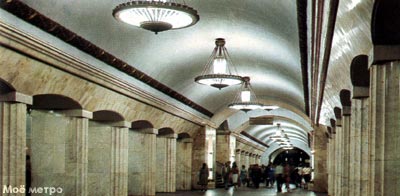 |
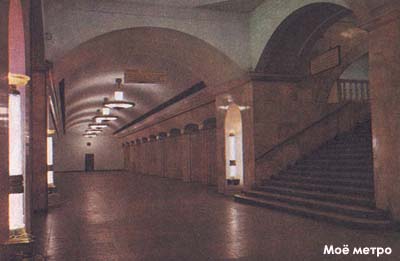 |
The speciality of this station are the niches
with the unique lamps in two colours, adding a very interesting
atmosphere to the whole main hall of the station. |
|
One of these niches without its lamp.
|
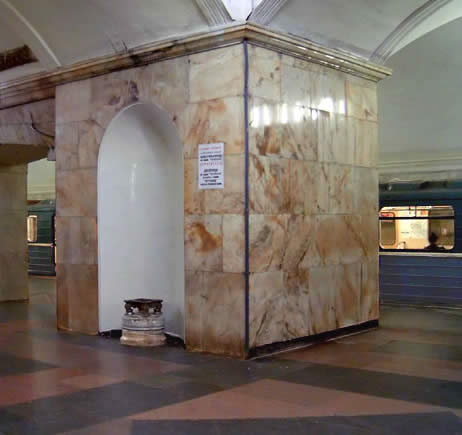 |
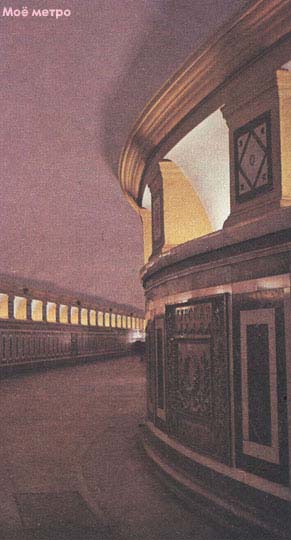 |
|
The passage uniting the Station with
the older Kurskaya Station on the Arbatsko-Pokrovskaya
Line.
This picture is originally taken
from an old Soviet post card series showing a lot
of details from the Moscow Underground.
|
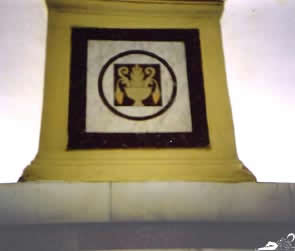
|
Detail from the passage (the columns
between the artificially lit windows)
|
|
The entrance hall with exits leading into the
underground and to the train station.
|
Then there is another line leading from the center to
the east-northeast: That is the line that originally connected the Kremlin
with Stalin’s dacha. It has been extended and after changes in the
late 80-ies now leads to other subterranean bunkers and command posts
outside Moscow and is, like the other secret lines, inaccessible not only
to the ordinary citizen, but to high-ranking politicians, too. It constitutes,
just as the buildings and accesses to the "Underground 2" and
its similiarly secret entrances, a military top secret.
There are two more secret lines existing that were built
in 1987 and ’88, preparing for a nuclear war. This is remarkable
as by then the Soviet Union was rather broke and these subterranean constructions
are very costly: Gorbachov and his cooperators, evidently, were preparing
for the worst scenario.
|
Taganskaya
Station
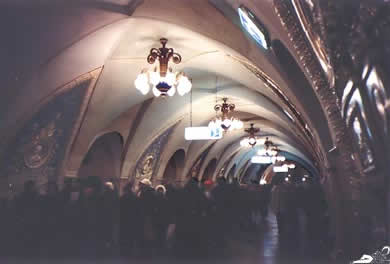 |
Taganskaya Station was opened in 1950.
Main hall
|
|
It is named after another "sloboda" in the outskirts
of 16th century Moscow whose inhabitants made racks for kettles
which were called "tagan". So the village was called
Taganka, and so were later a street and place in this area
after it was incorporated into Moscow.
On this street, near the underground station, is a theater
also called Taganka which was very famous in Brezhnyevs stagnation
period for its daring productions and its extravagant actors.
Details from the wall decoration. These
flame-like reliefs are made in majolica technique.
|
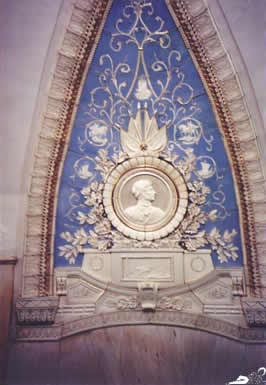 |
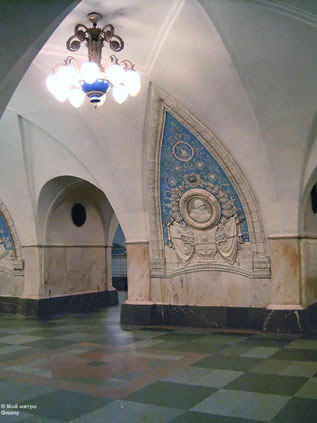 |
The figures inside the circle of the reliefs
represent officers or simple soldiers of importance in World
War II. |
|
Between the entrance hall on top and the main hall on
the bottom there is an intersection of the corridors with
a dome.
The ceiling of the dome is covered by a
mosaic with the title "Salute to Victory".
|
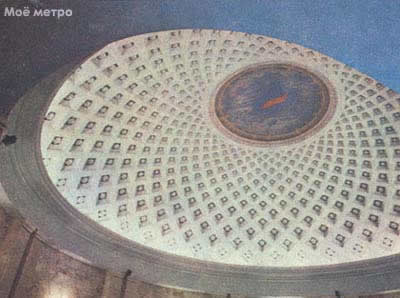 |
|
continuation
of the Ring Line
back to main page |





